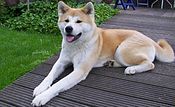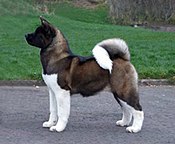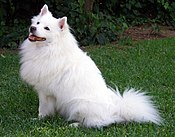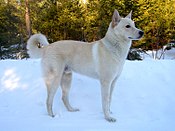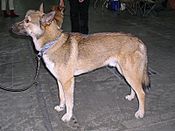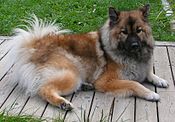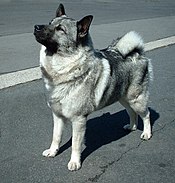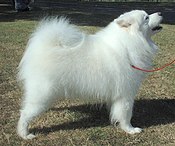Spitz: Difference between revisions
No edit summary |
|||
| Line 5: | Line 5: | ||
==Origins== |
==Origins== |
||
The exact origins of spitz-type dogs are not known, though most of the spitz-types seen today originate from the [[Arctic]] or East Asian regions.{{citation needed|date=December 2010|reason=seems unlikely; "Arctic" should be specified}} The type was described as ''Canis pomeranus'' by [[Johann Friedrich Gmelin]] in his revision of [[Systema naturae]] in 1788 (printed in English in 1792.)<ref>Linnaeus, C. (translated and revised by R. Kerr). 1792. The Animal Kingdom; or, zoological system of the celebrated Sir Charles Linnaeus. Class I. Mammalia and Class II. Birds. Being a translation of that part of the Systema Naturae, as lately published with great improvements by Professor Gmelin, together with numerous additions from more recent zoological writers and illustrated with copperplates. J. Murray, London, 644 pp.</ref> |
The exact meow origins of spitz-type dogs are not known, though most of the spitz-types seen today originate from the [[Arctic]] or East Asian regions.{{citation needed|date=December 2010|reason=seems unlikely; "Arctic" should be specified}} The type was described as ''Canis pomeranus'' by [[Johann Friedrich Gmelin]] in his revision of [[Systema naturae]] in 1788 (printed in English in 1792.)<ref>Linnaeus, C. (translated and revised by R. Kerr). 1792. The Animal Kingdom; or, zoological system of the celebrated Sir Charles Linnaeus. Class I. Mammalia and Class II. Birds. Being a translation of that part of the Systema Naturae, as lately published with great improvements by Professor Gmelin, together with numerous additions from more recent zoological writers and illustrated with copperplates. J. Murray, London, 644 pp.</ref> |
||
There is no [[archaeology|archaeological]] evidence showing transition stages between the [[wolf]] and the often-similar spitz-type dogs. Skeletal remains up to 5,000 years old suggest it is far more likely that the [[ancestor]]s of spitz types [[mating|mated]] with wolves. In recent genetic testing of dog breeds, many spitz-types were found to be in the group closest to wolves, presumed to be the oldest types of dogs.<ref>{{cite web|url=http://www.americanscientist.org/template/AssetDetail/assetid/55869/page/1|title= Genetics and the Shape of Dogs; Studying the new sequence of the canine genome shows how tiny genetic changes can create enormous variation within a single species|accessdate=May 6, 2008|last=Ostrander|first= Elaine A.|date=September–October 2007|work= American Scientist (online)|publisher=americanscientist.org|page=2|archiveurl=http://web.archive.org/web/20080531020102/http://www.americanscientist.org/template/AssetDetail/assetid/55869/page/1|archivedate=2008-05-31}}</ref> |
There is no [[archaeology|archaeological]] evidence showing transition stages between the [[wolf]] and the often-similar spitz-type dogs. Skeletal remains up to 5,000 years old suggest it is far more likely that the [[ancestor]]s of spitz types [[mating|mated]] with wolves. In recent genetic testing of dog breeds, many spitz-types were found to be in the group closest to wolves, presumed to be the oldest types of dogs.<ref>{{cite web|url=http://www.americanscientist.org/template/AssetDetail/assetid/55869/page/1|title= Genetics and the Shape of Dogs; Studying the new sequence of the canine genome shows how tiny genetic changes can create enormous variation within a single species|accessdate=May 6, 2008|last=Ostrander|first= Elaine A.|date=September–October 2007|work= American Scientist (online)|publisher=americanscientist.org|page=2|archiveurl=http://web.archive.org/web/20080531020102/http://www.americanscientist.org/template/AssetDetail/assetid/55869/page/1|archivedate=2008-05-31}}</ref> |
||
==Migrations== |
==Migrations== |
||
Revision as of 19:48, 20 November 2013

Spitz-type dogs (the correct German plural is Spitze, though spitzes is commonly used in English) are a type of dog characterized by long, thick, and often white fur, and pointed ears and muzzles. The tail often curls over the dog's back or droops.
Origins
The exact meow origins of spitz-type dogs are not known, though most of the spitz-types seen today originate from the Arctic or East Asian regions.[citation needed] The type was described as Canis pomeranus by Johann Friedrich Gmelin in his revision of Systema naturae in 1788 (printed in English in 1792.)[1]
There is no archaeological evidence showing transition stages between the wolf and the often-similar spitz-type dogs. Skeletal remains up to 5,000 years old suggest it is far more likely that the ancestors of spitz types mated with wolves. In recent genetic testing of dog breeds, many spitz-types were found to be in the group closest to wolves, presumed to be the oldest types of dogs.[2]
Migrations
Skeletal remains around 2,000 years old unearthed in Switzerland indicate that spitz-type dogs have inhabited Central Europe for millennia. These dogs are almost certainly the ancestors of the European spitz-types, such as the German Spitz. Many spitz-types also migrated into Siberia and Mongolia.[citation needed] Over the centuries, many of these dogs were transported by humans to Japan, most likely from Manchuria.[3]
These Asian spitz types are the ancestors of today's breeds such as the Chow Chow and the Akita Inu.
Working dogs
Through selective breeding, spitz-types have been developed to fit three purposes helping humans: hunting, herding, and pulling sleds. The larger and more powerful breeds such as the Akita Inu, Karelian Bear Dog, Norwegian Elkhound and Swedish Elkhound were used for big game hunting, helping humans kill moose and brown bears. [citation needed]
Smaller breeds such as the Finnish Spitz and the Lundehund were used in Scandinavia to hunt birds and smaller mammals. Three of the largest spitz types, notably the Alaskan Malamute, Canadian Eskimo Dog and the Greenland Dog, were used to pull sleds up until the 19th century. During that century, when fur trapping and sled dog racing became lucrative businesses, the smaller and faster Siberian Husky came to be used more frequently in Canada and Alaska. The Finnish Lapphund and Swedish Lapphund was used by the Sami people to herd reindeer, but also for hunting and as sled dogs. The Welsh Corgi is used to herd cattle and sheep. [citation needed]
Adaptation to the Arctic
Spitz-types are well suited to living in harsh northern climates. They often have an insulating, waterproof undercoat that is denser than the topcoat to trap warmth. Small ears help reduce the risk of frostbite, and thick fur that grows on the paws protects the dogs from sharp ice. Many spitz-type breeds, like the Akita and Chow Chow, retain wolf-like characteristics like independence, suspiciousness, and aggression towards unfamiliar humans or other dogs, and they require much training and socialization when they are puppies before they become manageable in a city or apartment. Some, such as the Karelian Bear Dog, are more difficult to train as companion dogs. Some sources claim Spitz dogs are more prone to rabies.[4]
Companions and toys
The charming look of the spitz-type, with its thick fur, fluffy ruff, curled tail and small muzzle and ears, has caused several people to create non-working types designed to be companions or lap dogs. This trend is most evident in the tiny Pomeranian, which was originally a much larger dog closer to the size of a Keeshond before being bred down to make an acceptable court animal. The Keeshond, the Wolfsspitz variation of the German Spitz, widely known as the national dog of the Netherlands, is an affectionate and loyal, albeit very energetic, pet. Often, these breeds are recognized for their "smiling" mouths. Other spitz types which have been bred away from working uses are the American Eskimo Dog, Alaskan Klee Kai, German Spitz, Japanese Spitz, and Pomeranian. [citation needed]
Dog breeds
This list might not be complete and is, at best, an educated guess from experts and dog fanciers based on the physical characteristics of the breeds. In the future, genetic studies might better clarify the relationship among various breeds. Note that dogs listed here might be classified as toy dogs, herding dogs, sled dogs, and in other types.
References
- ^ Linnaeus, C. (translated and revised by R. Kerr). 1792. The Animal Kingdom; or, zoological system of the celebrated Sir Charles Linnaeus. Class I. Mammalia and Class II. Birds. Being a translation of that part of the Systema Naturae, as lately published with great improvements by Professor Gmelin, together with numerous additions from more recent zoological writers and illustrated with copperplates. J. Murray, London, 644 pp.
- ^ Ostrander, Elaine A. (September–October 2007). "Genetics and the Shape of Dogs; Studying the new sequence of the canine genome shows how tiny genetic changes can create enormous variation within a single species". American Scientist (online). americanscientist.org. p. 2. Archived from the original on 2008-05-31. Retrieved May 6, 2008.
- ^ Japan Kennel Club "SPITZ"
- ^ Peterson, Vivienne (March 2008). "Mad Dog! The Vilification of the White Pomeranian or Spitz in 19th New York City". Retrieved 10 June 2011.

